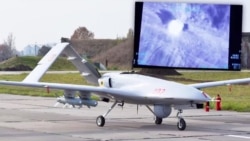On October 26, the Ukrainian Armed Forces’ General Staff released a video on Facebook showing the destruction of a D-30 122mm howitzer operated by Russian proxy forces in eastern Ukraine.
The strike was carried out using the Turkish-made Bayraktar TB2, an unmanned drone armed with an air-to-ground missile. While the strike destroyed the howitzer, it appears no one was injured, as two gunners can be seen running away after the explosion.
Ukraine purchased several of these attack drones from Turkey. It plans to produce them under license, Foreign Minister Dmytro Kuleba announced earlier this month.
The drone’s use provoked a dramatic response from Russian officials, who criticized it as an escalation while continuing to deny Russia’s well-established involvement in the Donbas conflict.
On October 28, Alexander Lukashevich, Russia’s permanent representative to the Organization for Security and Cooperation in Europe (OSCE), condemned the use of the drone.
"The use of such vehicles is banned by the Minsk Agreements,” the Russian state news agency TASS quote him as saying. “Also, flights of any type of drone, except OSCE Special Monitoring Mission drones, are prohibited by the measures on reinforcement of the ceasefire regime."
Those claims are false. The Minsk II protocols, which were first signed in 2015 with the aim of ending the conflict, do not ban the use of drones, which have been used frequently by both sides.
The protocols call for the removal of heavy weapons from the line of contact, meaning weapons of any caliber over 100mm, as well as rocket artillery systems. The D-30 howitzer destroyed by the TB2 drone is a 122mm weapon.
According to the October 26 statement by Ukraine’s General Staff, Ukrainian forces in the area where the incident occurred had come under fire from the D-30 battery, wounding two Ukrainian soldiers, one of whom later died. The statement claims that Ukrainian forces’ demand for a ceasefire, transmitted via the OSCE observers and diplomatic channels, went unheeded.
The OSCE SMM’s daily report for October 26 did not mention the drone strike, but cited 205 ceasefire violations, including 31 explosions, in the Donetsk oblast, the region where the drone strike took place and the howitzer was located.
Lukashevich’s claim that only OSCE SMM drones are permitted to fly in the conflict zone is misleading, given that SMM drones have been targeted by groundfire and electronic jamming in territory not controlled by Ukraine’s government. The OSCE SMM’s October 26 report recorded several such incidents.
“Ukraine protects its territory and its sovereignty in accordance with the duty and oath of everyone who serves today, who defends Ukrainian statehood,” Zelensky told reporters, according to the Ukrainian presidential website.
“We are not executing an offensive; we are just responding."






